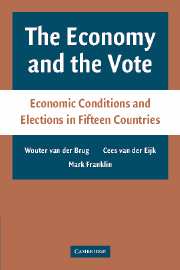Book contents
- Frontmatter
- Contents
- Preface
- Introduction
- 1 Studying Economic Voting
- 2 Party Choice as a Two-Stage Process
- 3 Hypotheses and Data: The Theoretical and Empirical Setting
- 4 Effects of the Economy on Party Support
- 5 The Economic Voter
- 6 From Individual Preferences to Election Outcomes
- 7 The Economy, Party Competition, and the Vote
- Epilogue: Where to Go from Here in the Study of Economic Voting?
- Appendix A The Surveys Employed in This Book
- Appendix B Detailed Results Not Reported in the Main Text
- References
- Index
7 - The Economy, Party Competition, and the Vote
Published online by Cambridge University Press: 18 December 2009
- Frontmatter
- Contents
- Preface
- Introduction
- 1 Studying Economic Voting
- 2 Party Choice as a Two-Stage Process
- 3 Hypotheses and Data: The Theoretical and Empirical Setting
- 4 Effects of the Economy on Party Support
- 5 The Economic Voter
- 6 From Individual Preferences to Election Outcomes
- 7 The Economy, Party Competition, and the Vote
- Epilogue: Where to Go from Here in the Study of Economic Voting?
- Appendix A The Surveys Employed in This Book
- Appendix B Detailed Results Not Reported in the Main Text
- References
- Index
Summary
In this book, we have made a point of separating the process by which party support propensities (and hence party preferences) are formed from the process of party choice. Our two-stage model, largely following Downs (1957), has allowed us to take account of different factors at each stage. With regard to the first stage, we were able to take account of independent variables that do not lend themselves to inclusion in conventional models of economic voting – models that focus on party choice as the dependent variable. In particular, separating the two stages enabled us to take account of party characteristics (such as their size and ideological complexion) at the first stage, when we modeled the formation of party preferences. In the second stage, when we modeled the choices that our respondents actually made, we were able to take into account the structure of electoral competition between parties – the aggregate-level counterparts of individual-level patterns of support propensities for the various parties.
In this final chapter, we will start by rehearsing our major objections to existing approaches that led to our adopting the two-stage model. We argued in Chapter 1 that the deficiencies that gave rise to our objections made it hard for past researchers to observe certain phenomena that we believed to be responsible for the instabilities and contradictions in extant research findings.
- Type
- Chapter
- Information
- The Economy and the VoteEconomic Conditions and Elections in Fifteen Countries, pp. 170 - 192Publisher: Cambridge University PressPrint publication year: 2007



